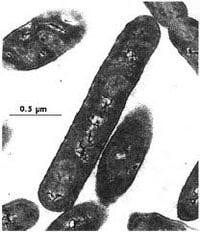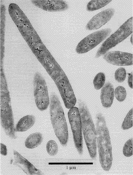Bacillus infernus: Difference between revisions
No edit summary |
No edit summary |
||
| Line 8: | Line 8: | ||
===Species=== | ===Species=== | ||
[[Image:infernus.gif|thumb|left|x175px|link=http://www.ncbi.nlm.nih.gov/pubmed/8590670|''Bacillus infernus'', a hyperthermophile, found 2.65-2.77 km beneath the Earth's surface. Photo courtesy of US Department of Energy- Subsurface Microbial Collection.]][[Image:infernus.jpeg|thumb|right|200px| | [[Image:infernus.gif|thumb|left|x175px|link=http://www.ncbi.nlm.nih.gov/pubmed/8590670|''Bacillus infernus'', a hyperthermophile, found 2.65-2.77 km beneath the Earth's surface. Photo courtesy of US Department of Energy- Subsurface Microbial Collection.]][[Image:infernus.jpeg|thumb|right|200px|link=http://geoweb.princeton.edu/research/geomicrobio/bacteria.html|Thin-section electron micrograph of Bacillus infernus, sp. nov., isolated from ca. 2.7 km below land surface in the Taylorsville Basin. These new species proposed by D. R. Boone et al. (1995) are thermophilic, halotolerant, and Fe(III)- and Mn(IV)-reducing anaerobes. Photo from http://geoweb.princeton.edu/research/geomicrobio/bacteria.html]][[Image:andromeda.jpg|thumb|Border|right|Alignment|Size|link=http://en.wikipedia.org/wiki/The_Andromeda_Strain_(2008_miniseries)|alt=Alt|Tests with ''B. infernus'' reveal that the bacterium easily consumes and destroys Andromeda because of Andromeda's sulfur structure....SCIENTIFIC?? NO!!! BUT FUN?? YES!!! Photo from Wikipedia.]] | ||
''Bacillus infernus'' | ''Bacillus infernus'' | ||
Revision as of 20:16, 28 April 2012
A Microbial Biorealm page on the genus Bacillus infernus
Classification
Higher order taxa
Bacteria; Firmicutes; Bacilli; Bacillales; Bacillaceae; Bacillus
Species

Bacillus infernus
Nonmotile rods (including possible yet unconfirmed endospores) inhabiting the deep terrestrial subsurface of the Taylorsville, Virginia Triassic Basin. The organism is thermophilic, halotolerant, and slightly alkaliphilic. B. infernus is important because it can affect geochemical processes including transport of toxic chemicals similar to other subsurface microorganisms. B. infernus also possesses a “novel” metabolism perhaps useful in future bioremediation of the environment, biotechnology, and industry.
Genome structure
Cell and colony structure
Interesting features of cell structure. Interesting features of colony structure.
Metabolism
Energy source(s); external electron donor(s) (=reductant source(s)); carbon source(s); oxygen classification; important molecules it produces.
Ecology
Habitat; symbiosis; contributions to the environment. metagenomic data link
Pathology
How does this organism cause disease? Human, animal, plant hosts? Virulence factors.
References
List your references here with hyperlinks to the papers or websites when possible. Also, provide the DOI number for articles. For example:
Edited by Matt Flynn, a student of Dr. Lisa R. Moore, University of Southern Maine, Department of Biological Sciences, http://www.usm.maine.edu/bio


